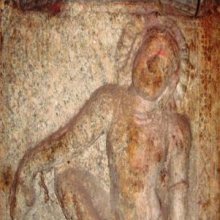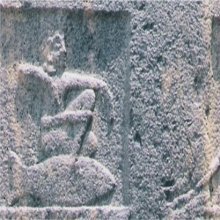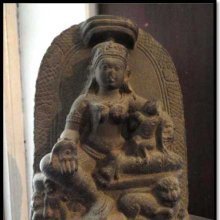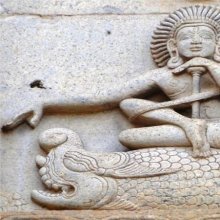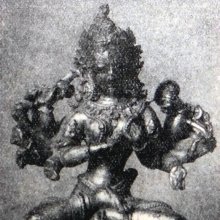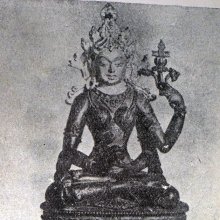Paryankasana, Paryanka-asana, Paryaṅkāsana, Paryamkasana: 8 definitions
Introduction:
Paryankasana means something in Hinduism, Sanskrit, Jainism, Prakrit. If you want to know the exact meaning, history, etymology or English translation of this term then check out the descriptions on this page. Add your comment or reference to a book if you want to contribute to this summary article.
Images (photo gallery)
(+2 more images available)
In Hinduism
Yoga (school of philosophy)
Source: Wisdom Library: YogaParyaṅkāsana (पर्यङ्कासन, “couch posture”) is a Sanskrit word referring to a type of posture (āsana) used in Yoga. It is composed of the words paryaṅka (couch) and āsana (posture).
Source: archive.org: Yoga Tradition of the Mysore PalaceParyaṅkāsana (पर्यङ्कासन) is a type of posture (āsana), according to verse 5 of the Śrītattvanidhi.—Accordingly, “Lying on the back, place the palms of the hands and the soles of thefeet on the floor. Then raise up the middle portion of the body. This is paryaṅkāsana, the couch”.
The 19th-century Śrītattvanidhi is a sanskrit treatise describing 80 primary āsanas, or ‘posture’ (e.g., paryaṅka-āsana) and several additional ones.
Iyengar has a paryaṅkāsana which has a similar idea of raising the midportion of the back from the floor. However the feet are in padmāsana positionand the arms are folded behind the head so that the elbows and forearms form the base at the front. The positions described and illustrated here would be dhanurāsana in Iyengar

Yoga is originally considered a branch of Hindu philosophy (astika), but both ancient and modern Yoga combine the physical, mental and spiritual. Yoga teaches various physical techniques also known as āsanas (postures), used for various purposes (eg., meditation, contemplation, relaxation).
Shilpashastra (iconography)
Source: Shodhganga: The significance of the mūla-beras (śilpa)Paryaṅkāsana (पर्यङ्कासन) or Vajrāsana in the Buddhist tradition corresponds with Padmāsana or Kamalāsana: a type of Āsana (sitting poses), according to Ganapati Sthapati in his text Ciṟpa Cennūl, as defined according to texts dealing with śilpa (arts and crafs), known as śilpaśāstras.—An image sitting cross-legged, with the feet facing upwards and resting on the thighs, and the body held erect, is said to be in padmāsana or kamalāsana. This posture is also known as paryaṅkāsana or vajrāsana in the Buddhist tradition. When one leg is folded, with the other foot resting on its thigh, it is called ardhapadmāsana.

Shilpashastra (शिल्पशास्त्र, śilpaśāstra) represents the ancient Indian science (shastra) of creative arts (shilpa) such as sculpture, iconography and painting. Closely related to Vastushastra (architecture), they often share the same literature.
Shaktism (Shakta philosophy)
Source: Google Books: ManthanabhairavatantramParyāṅkāsana (पर्याङ्कासन) refers to “sitting on a cot”, according to the Kulakaulinīmata 5.88-99.—Accordingly, “The goddess (Tripurabhairavī) is red like vermillion and the Bandhūka flower. She wears red clothes and is adorned with all the ornaments. She has matted hair and, peaceful, the moon is her crest jewel. She is replete with all (auspicious) characteristics and sits on a cot [i.e., sa-paryāṅkāsana]. She has large, round and upraised breasts, her navel has three folds, and she is adorned with (a fine) line of hair (travelling down from it). [...]”.

Shakta (शाक्त, śākta) or Shaktism (śāktism) represents a tradition of Hinduism where the Goddess (Devi) is revered and worshipped. Shakta literature includes a range of scriptures, including various Agamas and Tantras, although its roots may be traced back to the Vedas.
In Jainism
General definition (in Jainism)
Source: archive.org: The Jaina IconographyParyaṅkāsana (पर्यङ्कासन) or simply Paryaṅka refers to one of the various āsanas (postures) commonly depcited in Jain iconography.—Glossed as Padmāsana, which, in the Jaina Yogic texts, is described as a posture in which the Jaina or any devotee squats on a seat with legs folded, the right leg being on the left thigh and the left leg on the right thigh, while the eyes are fixed upon the tip of the nose. The position of the arms varies. There is a religious prescription to the effect that the image of Mahāvīra, Ṛṣabhanātha and Neminātha should be constructed in this posture or Āsana. The extant sculptures of the Tīrthaṃkaras mentioned do not always support the injunction.
Source: archive.org: TrisastisalakapurusacaritraParyaṅkāsana (पर्यङ्कासन) or simply Paryaṅka is the name of a posture (āsana), according to chapter 2.1 [ajitanātha-caritra] of Hemacandra’s 11th century Triṣaṣṭiśalākāpuruṣacaritra: an ancient Sanskrit epic poem narrating the history and legends of sixty-three illustrious persons in Jainism.
Accordingly, “the elephant of kings (i.e., Vimalavāhana) dismounted from the elephant’s shoulder and entered the garden, like a lion a mountain-cave. [...] He saw monks there, too, some in the [viz., paryaṅkāsana-posture, ...] some engaged in kāyotsarga, and some in ukṣa-posture, indifferent to the body, who had carried out their vows in the midst of numerous attacks, like soldiers in battles, victorious over internal enemies, enduring trials, powerful from penance and meditation [...] The King, with devotion sprouted in the guise of horripilation, as it were, approached Ācārya Arindama and paid homage to him”.
Source: OpenEdition books: VividhatīrthakalpaḥParyaṅkāsana (पर्यङ्कासन) refers to the position of the seated Jina, and represents a Jaina technical term mentioned in the Vividhatīrthakalpa by Jinaprabhasūri (13th century A.D.): an ancient text devoted to various Jaina holy places (tīrthas).—Note: There are two variants: the legs are either crossed (vajra-paryaṅka) or folded over one another (sattva-paryaṅka) (Bruhn 1969 p. 21).

Jainism is an Indian religion of Dharma whose doctrine revolves around harmlessness (ahimsa) towards every living being. The two major branches (Digambara and Svetambara) of Jainism stimulate self-control (or, shramana, ‘self-reliance’) and spiritual development through a path of peace for the soul to progess to the ultimate goal.
Languages of India and abroad
Kannada-English dictionary
Source: Alar: Kannada-English corpusParyaṃkāsana (ಪರ್ಯಂಕಾಸನ):—[noun] = ಪರ್ಯಂಕ - [paryamka -] 6
Kannada is a Dravidian language (as opposed to the Indo-European language family) mainly spoken in the southwestern region of India.
See also (Relevant definitions)
Partial matches: Asana, Paryanka.
Ends with: Ardhaparyankasana, Samparyankasana.
Full-text: Palliyankacanam, Vajrasana, Ardhaparyanka, Ardhaparyankasana, Padmasana, Vetrasana, Kamalasana, Paryanka.
Relevant text
Search found 10 books and stories containing Paryankasana, Paryanka-asana, Paryaṅkāsana, Paryaṅka-āsana, Paryamkasana, Paryaṃkāsana; (plurals include: Paryankasanas, asanas, Paryaṅkāsanas, āsanas, Paryamkasanas, Paryaṃkāsanas). You can also click to the full overview containing English textual excerpts. Below are direct links for the most relevant articles:
Bhagavati-sutra (Viyaha-pannatti) (by K. C. Lalwani)
Part 1 - More on monk’s power to transform < [Chapter 5]
Part 2 - On monk transforming into horse form, etc. < [Chapter 5]
Part 3 - Dialogue with Skandaka < [Chapter 1]
Jain Remains of Ancient Bengal (by Shubha Majumder)
Jain Tutelary Couple or Parents of the Tīrthaṅkaras < [Chapter 6 - Iconographic Study of Jaina Sculptural Remains]
Miniature Tīrthaṅkara and Planatary Deities type of Śāntinātha < [Chapter 6 - Iconographic Study of Jaina Sculptural Remains]
Images of Tīrthaṅkara Mallinātha < [Chapter 6 - Iconographic Study of Jaina Sculptural Remains]
Sripura (Archaeological Survey) (by Bikash Chandra Pradhan)
Scultures of Padmapani < [Chapter 3 - Sculptural Programme]
Scultures of Rakta-Lokesvara < [Chapter 3 - Sculptural Programme]
Scultures of Vajrapani < [Chapter 3 - Sculptural Programme]
Samkhya thoughts in the Mahabharata (by Shini M.V.)
Yoga Philosophy in Śānti-parva < [Chapter 3 - The Philosophical Tenets in the Śānti-parva]
Stupas in Orissa (Study) (by Meenakshi Chauley)
Emanations of Amoghasiddhi < [Chapter 5]
Minor Structural Stupas at Ratnagiri < [Chapter 4]
Minor Votive Stupas at Ratnagiri < [Chapter 4]
Amaravati Art in the Context of Andhra Archaeology (by Sreyashi Ray chowdhuri)
Nāga Muchalinda Episode < [Chapter 3 - Amarāvatī and the Formative Stage of the Buddhist Art]
Impact of Amarāvatī on early schools of art of South-East Asia < [Chapter 5 - Impact of Amarāvatī Art]
